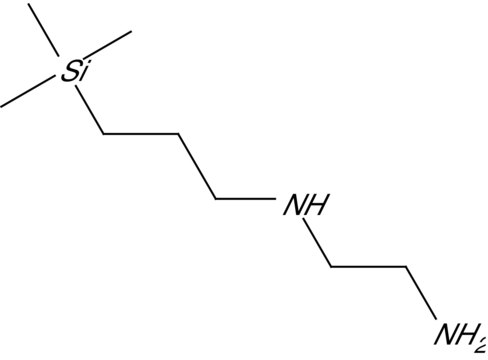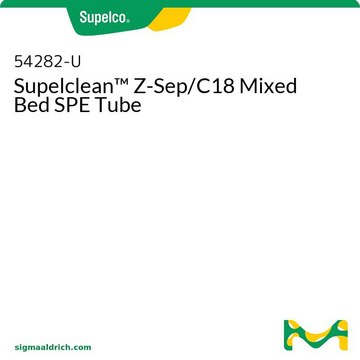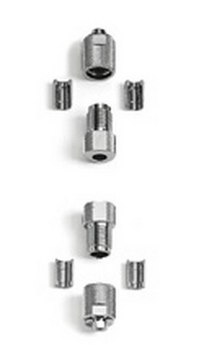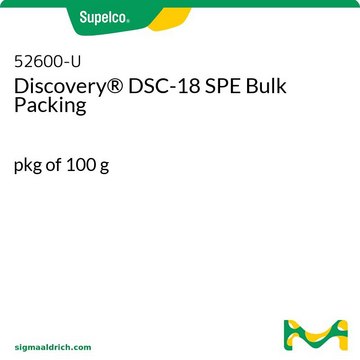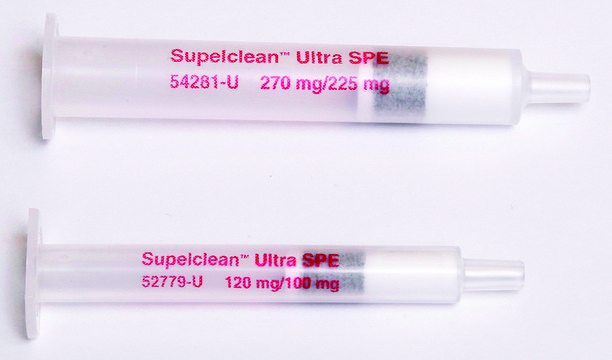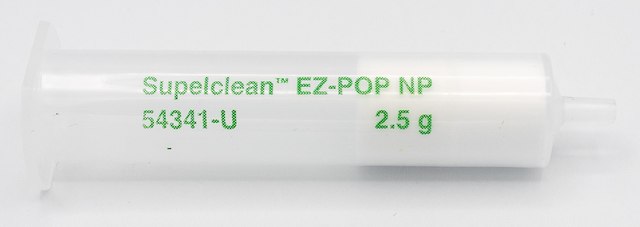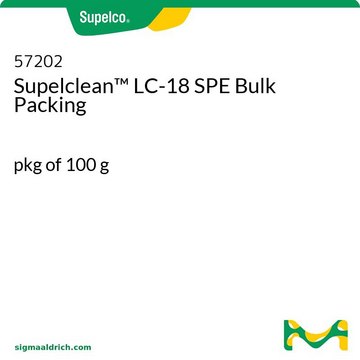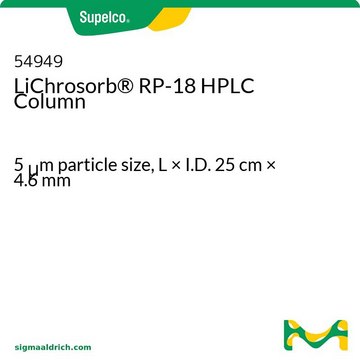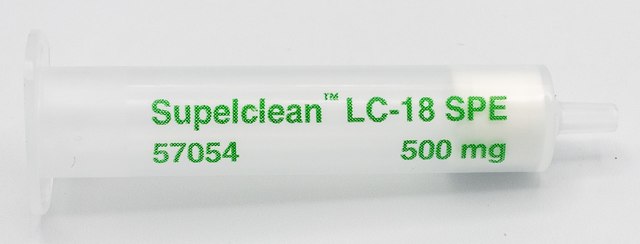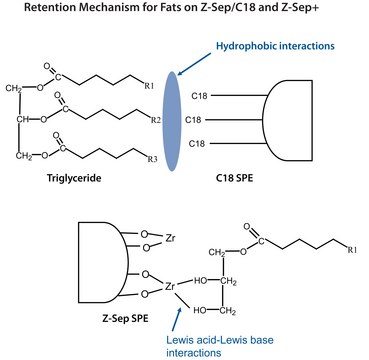55506-U
Supel™ QuE QuEChERS tube
Z-Sep/C18 Tube, pk of 50, centrifuge tube volume 15 mL , Shaker Compatible
Synonym(s):
QuEChERS
Sign Into View Organizational & Contract Pricing
All Photos(1)
About This Item
UNSPSC Code:
41115712
NACRES:
NB.21
Recommended Products
Product Name
Supel™ QuE, Z-Sep/C18 Tube, pk of 50, centrifuge tube volume 15 mL , Shaker Compatible
material
polypropylene tube
Quality Level
product line
Supel™
composition
Discovery® DSC-18, 300 mg
Z-Sep, 120 mg
packaging
pk of 50
technique(s)
QuEChERS: suitable
centrifuge tube volume
15 mL , Shaker Compatible
matrix active group
zirconia-based phase
application(s)
food and beverages
Looking for similar products? Visit Product Comparison Guide
General description
Dispersive SPE (dSPE), often referred to as the "QuEChERS" method (Quick, Easy, Cheap, Effective, Rugged, and Safe), is modern sample prep technique that is becoming increasingly popular in the area of multi-residue pesticide analysis in food and agricultural products.
Using the QuEChERS method, food/agricultural samples are first extracted with an aqueous miscible solvent (e.g., acetonitrile) in the presence of high amounts of salts (e.g., sodium chloride and magnesium sulfate) and/or buffering agents (e.g. citrate) to induce liquid phase separation and stabilize acid and base labile pesticides, respectively. Upon shaking and centrifugation, an aliquot of the organic phase is subjected to further cleanup using SPE. Unlike traditional methods using SPE tubes, in dispersive SPE, cleanup is facilitated by mixing bulk amounts of SPE (e.g., Supelclean PSA, ENVI-Carb, and/or Discovery DSC-18) with the extract. After sample cleanup, the mixture is centrifuged and the resulting supernatant can either be analyzed directly or can be subjected to minor further treatment before analysis.
Supelco carries a line of vials and centrifuge tubes containing pre-determined amounts of salts and SPE sorbents to support the most common method configurations used today.
Using the QuEChERS method, food/agricultural samples are first extracted with an aqueous miscible solvent (e.g., acetonitrile) in the presence of high amounts of salts (e.g., sodium chloride and magnesium sulfate) and/or buffering agents (e.g. citrate) to induce liquid phase separation and stabilize acid and base labile pesticides, respectively. Upon shaking and centrifugation, an aliquot of the organic phase is subjected to further cleanup using SPE. Unlike traditional methods using SPE tubes, in dispersive SPE, cleanup is facilitated by mixing bulk amounts of SPE (e.g., Supelclean PSA, ENVI-Carb, and/or Discovery DSC-18) with the extract. After sample cleanup, the mixture is centrifuged and the resulting supernatant can either be analyzed directly or can be subjected to minor further treatment before analysis.
Supelco carries a line of vials and centrifuge tubes containing pre-determined amounts of salts and SPE sorbents to support the most common method configurations used today.
Compatibility
Compatible with most QuEChERS shakers.
Other Notes
Supel™ QuE Z-Sep products enhance sample cleanup for complex matrices by effectively removing more fat and color from sample extracts than traditional phases for QuEChERS methods. By eliminating problematic matrix interferences, Z-Sep products provide more robust LC-MS and GC-MS methods. This proprietary technology can replace C18 and PSA in your current methods without additional method development.
Z-Sep+ is recommended for cleanup of samples containing greater than 15% fat.
Z-Sep/C18 is recommended for cleanup of samples containing less than 15% fat.
Z-Sep is recommended for cleanup of samples prior to analysis of hydrophobic analytes.
Z-Sep+ is recommended for cleanup of samples containing greater than 15% fat.
Z-Sep/C18 is recommended for cleanup of samples containing less than 15% fat.
Z-Sep is recommended for cleanup of samples prior to analysis of hydrophobic analytes.
Legal Information
Certain uses of this product may be covered by the claims of one or more pending patent applications. For licensing inquiries please contact techserv@sial.com
AOAC is a registered trademark of AOAC International
Discovery is a registered trademark of Merck KGaA, Darmstadt, Germany
Supel is a trademark of Sigma-Aldrich Co. LLC
Storage Class Code
11 - Combustible Solids
WGK
WGK 3
Flash Point(F)
Not applicable
Flash Point(C)
Not applicable
Choose from one of the most recent versions:
Already Own This Product?
Find documentation for the products that you have recently purchased in the Document Library.
Martina Rejtharová et al.
Food additives & contaminants. Part A, Chemistry, analysis, control, exposure & risk assessment, 35(2), 233-240 (2017-10-06)
A sensitive and robust confirmatory method for determination of steroid esters in blood serum is essential for reliable monitoring of possible illegal use of steroid hormones as growth promoters in meat production. A previously used sample preparation methodology was improved.
Ana Lozano et al.
Talanta, 118, 68-83 (2013-11-28)
Two sorbents containing ZrO₂ (Z-Sep and Z-Sep+) were tested as a d-SPE clean-up in combination with the QuEChERS and ethyl acetate multiresidue method in the pesticide residues extraction in avocado. All extracts were analysed using gas chromatography coupled with a
Jonatan V Dias et al.
Journal of chromatography. A, 1462, 8-18 (2016-08-11)
The goal of this work was to evaluate the efficiency of several sorbents on removal fats from edible oils (olive, soya and sunflower) during the clean-up step for posterior determination of 165 pesticides by UHPLC-QqQ-MS/MS system. The extraction procedure employed
Piotr Kaczynski et al.
Ecotoxicology and environmental safety, 139, 124-131 (2017-01-28)
Highly toxic insecticides (HTIs) belonging to different chemical groups are dangerous to pollinating organisms, even in sublethal doses. An important objective of this study was to develop a method to determine over fifty HTIs at very low concentrations in the
Darina Lankova et al.
Analytical and bioanalytical chemistry, 408(10), 2515-2525 (2016-02-11)
In this study, a novel analytical approach for the determination of 11 monohydroxylated polycyclic aromatic hydrocarbon metabolites (OH-PAHs) in urine was developed and validated. The rapid, simple and high-throughput sample preparation procedure based on ethyl acetate extraction and subsequent purification
Our team of scientists has experience in all areas of research including Life Science, Material Science, Chemical Synthesis, Chromatography, Analytical and many others.
Contact Technical Service